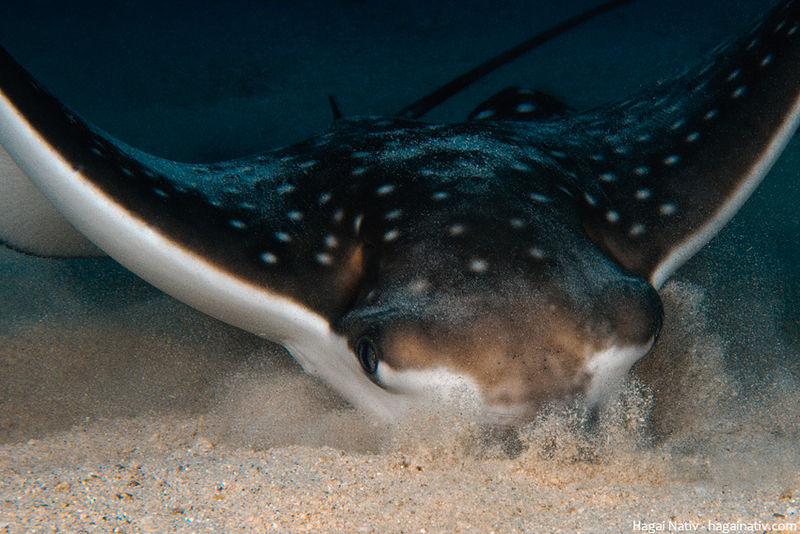Interactions
Spotted Eagle Rays are carnivores that prey on shellfish such as clams, oysters, hermit crabs and whelks, sea urchins, and sometimes lobster, octopi and fish (Beautiful Oceans, Bester, Maui Ocean Center, Schluessel et al. 2010). As mentioned on the Form and Function page, in order to acquire food, A. narinari will use its electrosensory system to determine the location of prey in buried in the sand and then use its duck bill-shaped snout to dig down deep enough to capture it (Bester 2014). On occasion, Spotted Eagle Rays will turn over rocks and even poke their heads into caves and other small rock openings in search for food (Beautiful Oceans 2014).
A. narinari may be seen feeding during the day or at night but
depends more specifically on the tides. During high tide and rising tide
is when most foraging for food occurs since during low and falling tides
the Spotted Eagle Rays are most often found offshore resting, often in
groups (Beautiful Oceans 2014).
A number of parasitic relationships are found among the A. narinari.
The most common is trematodes Thaumatocotylepse udodasybatis,
which infects the skin of the Spotted Eagle Rays (Bester 2014). In Australia
Clemacotyle australis was found in the bronchial cavity of an
individual and Decacotyle octona n. comb. was found in the
lungs of another. There are two types of tapeworms, Acanthobothrium
monski n. sp. and A. nicoyalnse n. sp., which are
sometimes found among Aetobatus narinari. Finally, an
individual in the waters of Venezuela was found to have a marine leech
Branchellion torpedinis on its pelvic fins.
Predators of A. narinari are limited to some shark species
including tiger sharks, bull sharks, lemon sharks, hammerhead sharks and
silvertip sharks (Beautiful Oceans, Pederson 2014). Due to the large size of
the Spotted Eagle Rays, sharks are usually the only other organisms
capable of preying on them and predation of A. narinari is not
often observed (Chapman 2002). Sharks often follow A. narinari
around the time of the birthing season in order to feed on the newborn
pups since this is the time that they are most defenseless (Pederson
2014).
Humans in some places of the world do harvest A. narinari to be
used as fishmeal and oil (Bester 2014).
Spotted Eagle Rays are rarely used for their meat since the flesh is such poor quality and there are very few places that will serve any type of string ray meat. Unfortunately, sometimes A. narinari is killed in an attempt to prevent over feeding on shellfish that would have otherwise been farmed and used for a profit (Beautiful Oceans 2014, Richards 2009). This has lead to Spotted Eagle Rays being listed as “near threatened” on the IUCN Red List and it is entirely possible that this status will change to “threatened” if unnecessary slaughtering continues (MarineBio 2014).
<< Go back to our Home page! >>

